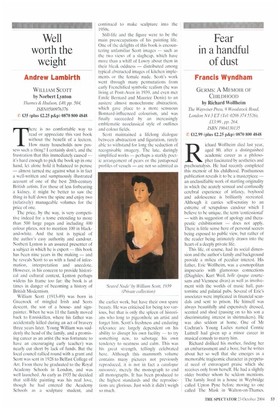Well worth the weight
Andrew Lambirth
WILLIAM SCOTT by Norbert Lynton lhames & Hudson, £40, pp. 504, 1SBN0500976376 ".C) £35 (plus 12.25 p&p) 0870 800 4848 There is no comfortable way to read or appreciate this vast book without the benefit of a lectern. How many households now possess such a thing? I certainly don't, and the frustration that this immediately caused — its hard enough to pick the book up in one hand, let alone hold it balanced to peruse — almost turned me against what is in fact a well-written and sumptuously illustrated account of one of the best 20th-century British artists. For those of less forbearing a kidney, it might be better to saw the thing in half down the spine and enjoy two (relatively) manageable volumes for the price of one.
The price, by the way, is very competitive indeed for a tome extending to more than 500 large pages and including 400 colour plates, not to mention 100 in blackand-white. And the text is typical of the author's easy authority and candour. Norbert Lynton is an assured presenter of a subject in which he is expert this book has been nine years in the making — and he reveals Scott to us with a fund of information, interpretation and anecdote. However, in his concern to provide historical and cultural context, Lynton perhaps widens his frame too far: the book is at times in danger of becoming a history of British Modernism.
William Scott (1913-89) was born in Greenock of mingled Irish and Scots descent, the son of a houseand signpainter. When he was 11 the family moved back to Enniskillen, where his father was accidentally killed during an act of bravery three years later. Young William was suddenly the head of the family, and a promising career as an artist (he was fortunate to have an encouraging early teacher) was nearly cut short by lack of funds. But the local council rallied round with a grant and Scott was sent in 1928 to Belfast College of Art. From there he graduated to the Royal Academy Schools in London, and was well launched. As early as 1935 he decided that still-life painting was his real love, though he had entered the Academy Schools as a sculpture student, and continued to make sculpture into the 1950s.
Still-life and the figure were to be the main preoccupations of his painting life. One of the delights of this book is encountering unfamiliar Scott images — such as the two views of a slagheap, which have more than a whiff of Lowry about them in their bleak oddness — distributed among typical abstracted images of kitchen implements or the female nude. Scott's work went through many permutations from early Frenchified symbolic realism (he was living at Pont-Aven in 1939, and even met Emile Bernard and Maurice Denis) to an austere almost monochrome abstraction, which gave place to a more sensuous Bonnard-influenced colourism, and was finally succeeded by an increasingly emblematic neoclassical style of outlines and colour fields.
Scott maintained a lifelong dialogue between abstraction and figuration, rarely able to withstand for long the seduction of recognisable imagery. The late, daringly simplified works — perhaps a starkly poetic arrangement of pears or the juxtaposed profiles of vessels — are not so admired as the earlier work, but have their own spare beauty. He was criticised for being too various, hut that is only the spleen of historians who long to pigeonhole an artist and forget him. Scott's freshness and enduring relevance are largely dependent on his
ability to disrupt his own facility to try something new, to sabotage his own tendency to neatness and calm. This was his great strength, tellingly celebrated here. Although this mammoth volume contains many pictures not previously reproduced, it is not in fact a catalogue raisonnee, merely the monograph to end all monographs. It has been produced to the highest standards and the reproductions are glorious. Just wish it didn't weigh so much.
























































































 Previous page
Previous page